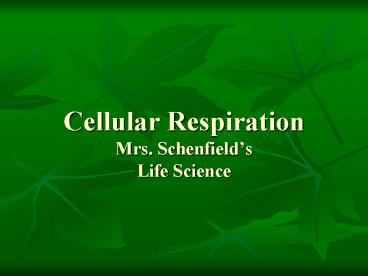Cellular Respiration Mrs' Schenfields Life Science PowerPoint PPT Presentation
1 / 14
Title: Cellular Respiration Mrs' Schenfields Life Science
1
Cellular RespirationMrs. SchenfieldsLife
Science
2
Cellular Respiration Overview
- Transformation of chemical energy in food into
chemical energy cells can use ATP - These reactions proceed the same way in plants
and animals. Process is called cellular
respiration - Overall Reaction
- C6H12O6 6O2 ? 6CO2 6H2O
3
Cellular Respiration Overview
- Breakdown of glucose begins in the cytoplasm
the liquid part called cytosol - Sugar is the most common energy source (some
cells use fats and proteins - Requires many enzymes
- The enzymes disassembly line takes the sugar
apart, periodically releasing small amounts of
energy that fuel the cell
4
Types of Cellular Respiration
- At this point life diverges into two forms and
two pathways - Anaerobic cellular respiration (fermentation)
- Aerobic cellular respiration
5
Cellular Respiration Reactions
- Glycolysis
- Series of reactions which break the 6-carbon
glucose molecule down into two 3-carbon molecules
called pyruvate - Process is an ancient one-all organisms from
simple bacteria to humans perform it the same way - Yields 2 ATP molecules for every one glucose
molecule broken down
6
(No Transcript)
7
Anaerobic Cellular Respiration
- Some organisms thrive in environments with little
or no oxygen - Marshes, bogs, gut of animals, sewage treatment
ponds - No oxygen used anaerobic
- Results in no more ATP, final steps in these
pathways serve ONLY to regenerate NAD so it can
return to pick up more electrons and hydrogens in
glycolysis. - End products such as ethanol and CO2 (single cell
fungi (yeast) in beer/bread) or lactic acid
(muscle cells)
8
Anaerobic Cellular Respiration
- Alcoholic Fermentation-some bacteria and fungi
use this as their only source of energy. - Yeast in bread dough uses this and produces
carbon dioxide that gets trapped in the dough and
causes bread to rise. - Yeast is a leavening agent and is mentioned in
the Bible. - (enzymes)
- Sugar carbon dioxide 2-3 ATP
9
Anaerobic Cellular Respiration
- Lactic Acid Fermentation-produced and released by
bacteria in yogurt, buttermilk, and sauerkraut. - If, when you exercise, you are not able to supply
enough oxygen to muscle cells they will switch to
anaerobic respiration which produces lactic acid. - The build of lactic acid causes soreness in
muscles. - Not as efficient as aerobic cellular respiration
10
(No Transcript)
11
Aerobic Cellular Respiration
- Oxygen requiredaerobic
- Mitochondria perform the recharging of ATP
molecules by transferring energy from the sugar
molecules to ATP. - (enzymes)
- Sugar oxygen carbon dioxide water
26-28 ATP - The cells of many organisms and your body perform
this type of cellular respiration.
12
(No Transcript)
13
Energy Tally
- 36 ATP for aerobic vs. 2 ATP for anaerobic
- Glycolysis 2 ATP
- Krebs 2 ATP
- Electron Transport 32 ATP
- 36 ATP
- Anaerobic organisms cant be too energetic but
are important for global recycling of carbon
14
(No Transcript)

